NYC’s Forgotten ‘War on Christmas Trees’
Discover how an obscure holiday crackdown affects festive street vendors today!


One of the highlights of the comprehensive exhibition, Saving Place: 50 Years of NYC Landmarks at the Museum of the City of New York, is the collection of architectural remnants from New York City’s buildings, both lost and still standing. From a marble eagle head from the original Pennsylvania Station to original lime moldings from Grand Central Terminal and cast iron medallions from the Battery Maritime Terminal, there is plenty for architecture and preservation buffs to revel in.
To procure the objects, co-curator Andrew Dolkart tells Untapped Cities that they “visited several firms that specialize in the preservation and restoration of landmark buildings” to find the objects. Curator Donald Albrecht adds, “there are also building components from buildings that have been restored. There are tiles from Bethesda Terrace, there are old and new brick from Carnegie Hall, and there are marble panels from the Metropolitan Life Building.”
Without further ado, here are some of the unique finds in the exhibition Saving Place: 50 Years of NYC Landmarks:
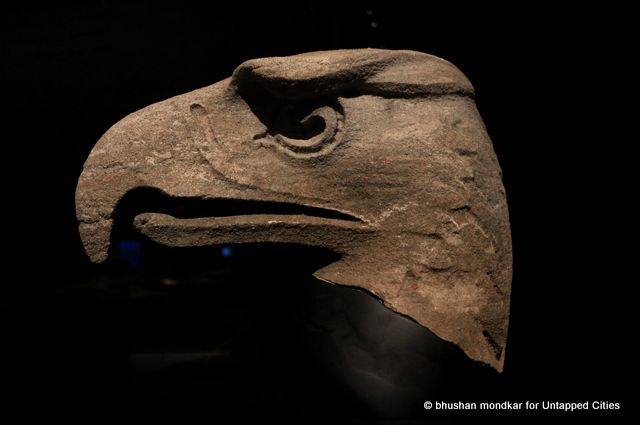
22 marble eagles once graced the facade of the original Pennsylvania Station by McKim, Mead and White. Many of the eagle heads were salvaged by concerned citizens, rail workers, and educators, other sculptures would later be salvaged from dumping grounds in the Meadowlands.
The marble eagle head on display in Saving Place: 50 Years of NYC Landmarks likely flanked the sculptural group Day and Night by Adolph Weinman above the entrances of Penn Station. It was saved by Albert Fritsch, a mechanic for the Pennsylvania Railroad, who allegedly saw it in the rubble one day before heading home on the train. It was displayed on Fritsch’s lawn for decades in Freeport, New York, and later in Poughkeepsie after his passing.
Dave Morrison, a Pennsylvania Station expert confirmed its origin and the eagle was temporarily on display at the Transit Museum’s Grand Central Annex in 2011 for the exhibit “The Once and Future Penn Station.” You can see it in person again at Saving Place: 50 Years of NYC Landmarks.
Check out where 15 other marble eagle heads of Penn Station are located and take a tour of the remnants of the original Penn Station with us:
Tour of the Remnants of Penn Station
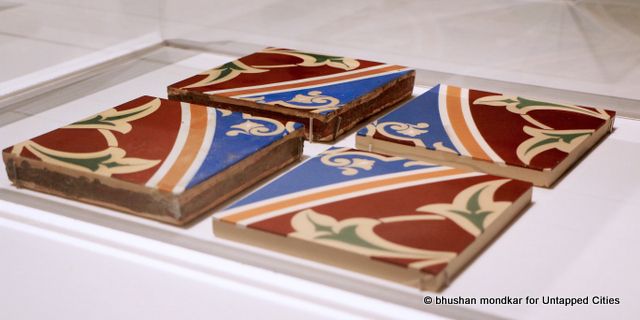
From the exhibition Saving Place: 50 Years of New York City Landmarks
There are two new tiles and two original tiles from Bethesda Terrace in Central Park, restored in 2000. On the ceiling of the oft-photographed arcade there are 15,000 tiles, manufactured by the Minton Tile Company in England, designed by British-born architect and designer Jacob Wrey Mould. According to the Central Park Conservancy, “Encaustic tiles, originally created to cover floors, are made of individual colored clays pressed and fired into the tile to form the design. Bethesda arcade is the only place in the world where these Minton tiles are used for a ceiling.”
As you can see from the photograph, the older tiles are slightly thicker at 7/8″, and the new at 5/16″.
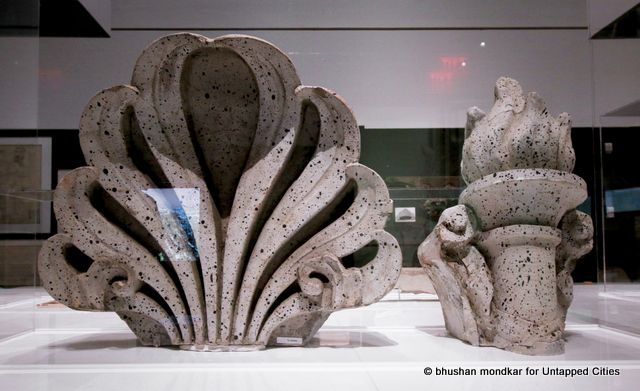
From the exhibition Saving Place: 50 Years of New York City Landmarks
These two pieces of terra cotta ornamentation come from the post office across Penn Station, now known as Moynihan Station (previously the James A. Farley Post Office). Moynihan Station will be the future home of Amtrak and the post office is still operational there, with an overlooked Museum of Postal History as well as much unused space, repurposed for special events like fashion shows and art installations.
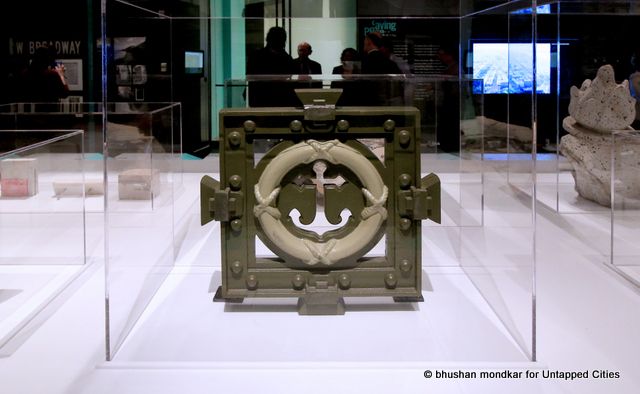
From the exhibition Saving Place: 50 Years of New York City Landmarks
The Battery-Maritime Building, where the Governors Island ferry departs from, underwent a $36 million restoration from 2001 to 2005. This cast-iron medallion is a 2009 recreation of a 1907 original, and weighs 350 pounds. The medallion comes from the collection of Jan Hird Pokorny Associates, the firm that handled the renovation. The exhibition also has a original decorative metal piece from the building:
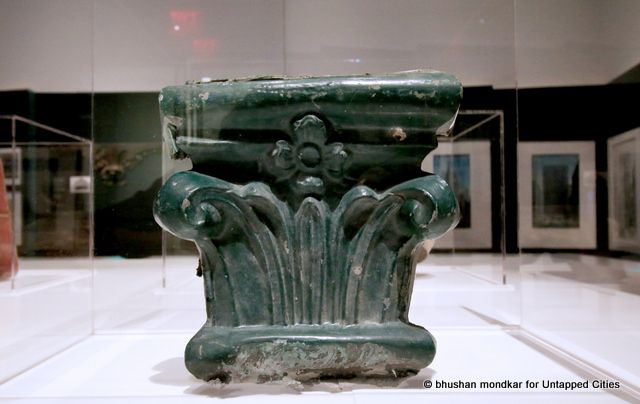
An original decorative metal piece from the Battery Maritime Building. From the exhibition Saving Place: 50 Years of New York City Landmarks
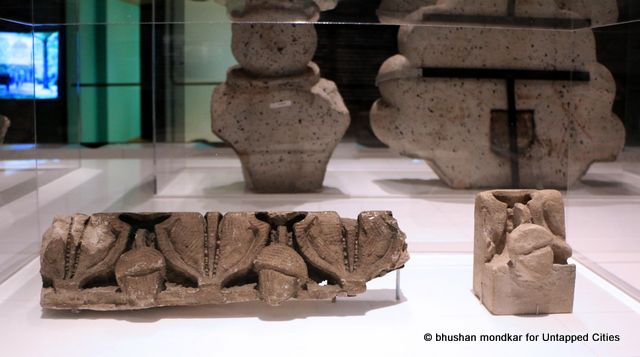
From the exhibition Saving Place: 50 Years of New York City Landmarks
On the left is an original exterior limestone molding from Grand Central Terminal. On the right is a replacement cast stone molding. As curator Donald Albrecht tells Untapped Cities, visitors to the exhibition “may be surprised that they actually were going to tear down Grand Central Terminal at one point. What the preservation movement is about and what it was about in the past is more than you think it is.”
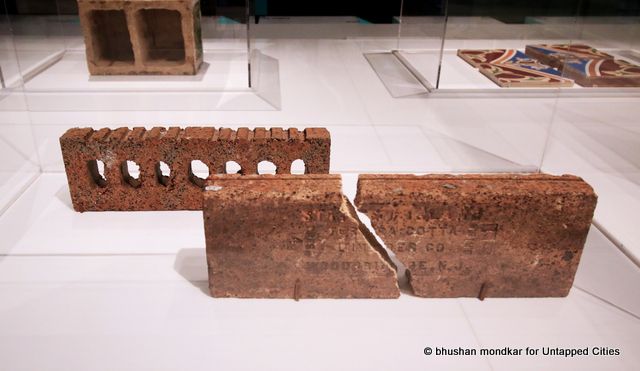
From the exhibition Saving Place: 50 Years of New York City Landmarks
On the right is an original brick from the facade of Carnegie Hall, in a distinctive iron-spotted terra cotta. In the back is the replacement brick, of slightly smaller dimensions with holes cut out in the brick. As reviewed in The New York Times, “Not the least of the pleasures of this restored facade is the reminder it offers that superb craftsmanship and traditional materials are still available, if not as plentiful as in the past. Neither the newly made terra cotta nor the new Roman brick are noticeably inferior to the originals, and if this same level of care is carried all the way around the building’s exterior, Carnegie Hall will come to look as it always should have.”
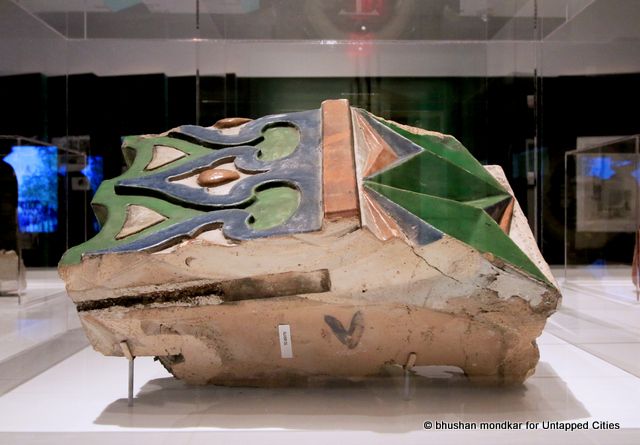
From the exhibition Saving Place: 50 Years of New York City Landmarks
This terra cotta piece is from the facade of New York City Center, not far from Carnegie Hall. Built in the Moorish Revival style, it was formerly known as the Mecca Temple, run by the Ancient Arabic Order of the Nobles of the Mystic Shrine, or the Shriners, who used to hold their meetings in Carnegie Hall. Not surprisingly, architect Harry P. Knowles was a master mason. In 2010, the building underwent a $75 million renovation.
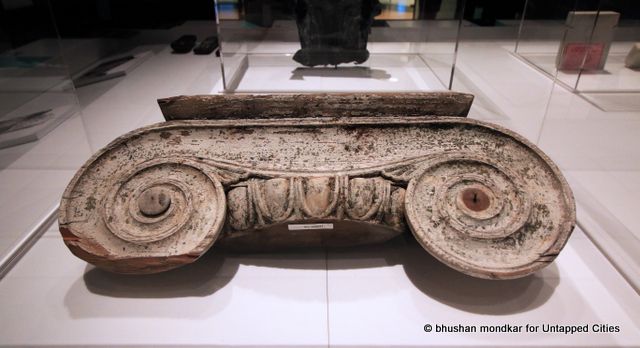
From the exhibition Saving Place: 50 Years of New York City Landmarks
This wooden capital in the Ionic style comes from the Octagon, an apartment building on Roosevelt Island that was once the New York City Lunatic Asylum, opened in 1841. The building also served as the entrance to the Metropolitan Hospital in 1890s. Abandoned in the 1950s, it was restored by Becker + Becker in the 2006.
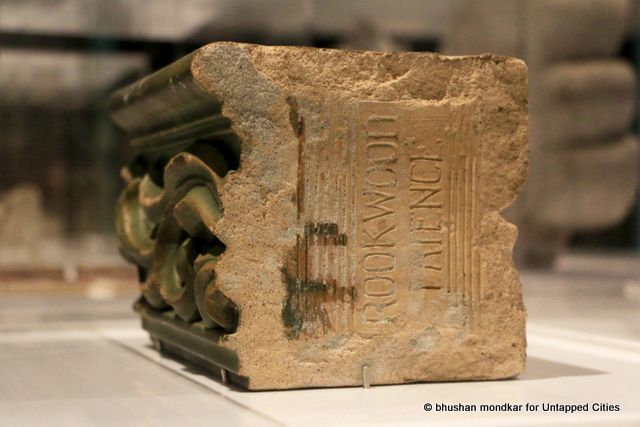
From the exhibition Saving Place: 50 Years of New York City Landmarks
As Fulton Center was being planned and built, the subway station below was undergoing renovation. As we covered previously, the terra cotta details in this station were an important piece of the conservation work. The Beaux-Arts ornamentation to beautify the subway stations were once a way to make the underground hospitable, comforting and impressive to the city’s commuters, many who were afraid of the “unnaturalness” of underground travel initially. This original faience element was produced by Rookwood Pottery.
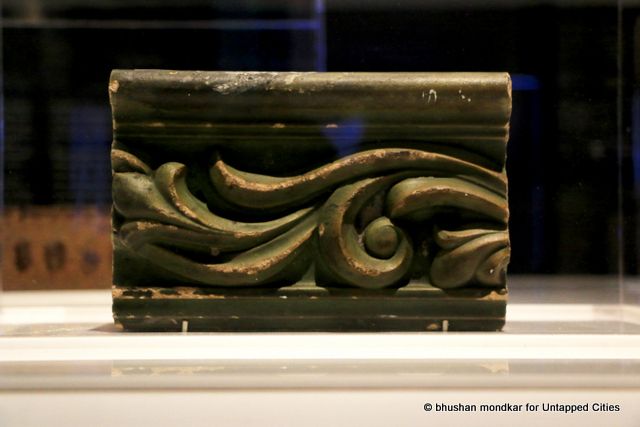
From the exhibition Saving Place: 50 Years of New York City Landmarks
The Fulton Street subway also has remnants of its own, terra cotta murals salvaged from the Hotel McAlpin in Herald Square, along with a cast iron gate.
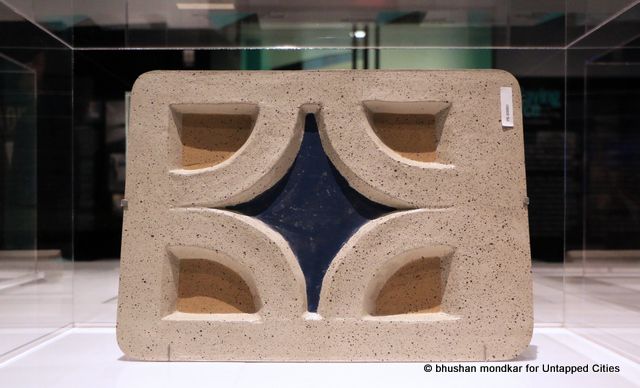
From the exhibition Saving Place: 50 Years of New York City Landmarks
This is a fiberglass sample used for the renovation of the balustrade in the Brooklyn Academy of Music (BAM).
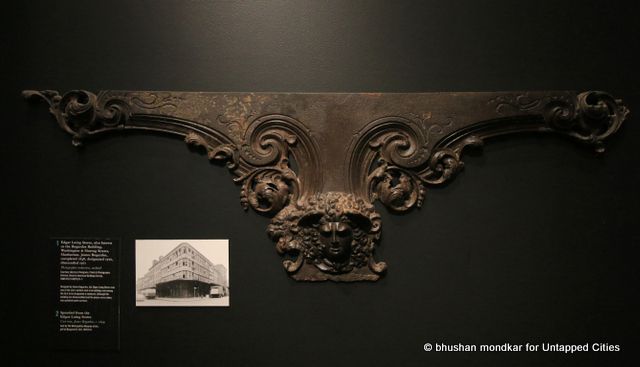
From the exhibition Saving Place: 50 Years of New York City Landmarks
This spandrel panel comes from the Bogardus Building (also known as the Edgar Laing Stores) at Washington and Murray Street, one of the city’s earliest cast-iron and curtain-walled buildings and one of the first to be designated a landmark. The building was disassembled as the area was prepared for urban renewal to be reconstructed at the new campus of Manhattan Community College, but the pieces were stolen and sold for scrap (twice).
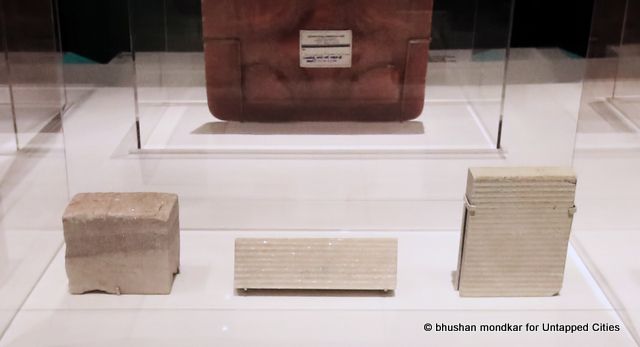
On the left is an original Tuckahoe marble brick from the Metropolitan Life Building, once a popular material for buildings in New York City. Today, the quarries are closed, so the renovation work on the Metropolitan Life Insurance Company Tower used a marble boulder in Tuckahoe instead (center block in image), and on the right is a cast stone replica.
Many of the architectural remnants are displayed in glass cases central to the exhibition, along with architectural models. In total, the curated pieces offer a snapshot of the triumphs and failures of the preservation movement in New York City, surrounded by a timeline of Landmark Law’s fifty years, as well as the movement for its recreation which dates as early as 1890.
The exhibition Saving Place: 50 Years of New York City Landmarks is open now until September 13th. Read on for our interview with curators Donald Albrecht and Andrew Dolkart, and our preview of the exhibit. Get in touch with the author @untappedmich.
Subscribe to our newsletter